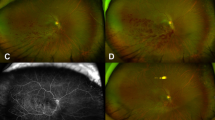Abstract
Background
A macular hole can develop as a late complication secondary to a branch retinal vein occlusion (BRVO). We report about an atypical horseshoe-like tear occurring in the fovea after recurrent BRVO.
Methods
An interventional case report.
Results
In 1997, a 53-year-old man was seen with an occlusion of macular part of inferior temporal vein of the retina on the left eye. After experiencing several recurrent BRVO in this eye, 6 years later he presented with a horseshoe-like tear in the fovea. Visual acuity was 20/200. The patient underwent standard three-port vitrectomy and installation of C3F8 16%. Intraoperatively, massive traction of the vitreous was detected on the edges of the tear. Six months after the operation, the tear remained attached. The visual acuity was 20/200.
Conclusions
The uniqueness of the presented case is the occurrence of a macular tear following recurrent BRVO, its horseshoe-like shape and foveal location. To the best of our knowledge, this is the first report on a horseshoe-like tear seen in the fovea secondary to BRVO. We assume that chronic macular edema and retinal ischemia following BRVO were additional factors beside the vitreous traction, contributing to the formation of the macular tear. Anatomical closure of the tear and stabilisation of visual acuity can be achieved by vitreoretinal surgery.


Similar content being viewed by others
References
Fong AC, Schatz H, McDonald HR, Burton TC, Maberley AL, Joffe L, Zegarra H, Nadel AJ, Johnson RN (1992) Central retinal vein occlusion in young adults (papillophlebitis). Retina 12:3–11
Gass JD (1995) Reappraisal of biomicroscopic classification of stages of development of a macular hole. Am J Ophthalmol 119:752–759
Ikuno Y, Tano Y, Lewis JM, Ikeda T, Saro Y (1997) Retinal detachment after branch retinal vein occlusion: influence of the type of break on the outcome of vitreous surgery. Ophthalmology 104:27–32
Joondeph HC, Joondeph BC (1988) Posterior tractional retinal breaks complicating branch retinal vein occlusion. Retina 8:136–140
Leibovitch I, Azmon B, Pianka P, Alster Y, Loewenstein A (2003) Macular hole secondary to branch retinal vein occlusion diagnosed by Retinal Thickness Analyser. Ophthalmic Surg Lasers Imaging 34:53–56
Author information
Authors and Affiliations
Corresponding author
Additional information
There is no financial interest to declare. No grant has been received in relation to this case.
Rights and permissions
About this article
Cite this article
Karim-Zade, K., Bilgic, A., Bartz-Schmidt, K.U. et al. Horseshoe-like macular tear following recurrent branch retinal vein occlusion. Graefes Arch Clin Exp Ophthalmol 245, 1221–1223 (2007). https://doi.org/10.1007/s00417-006-0508-y
Received:
Revised:
Accepted:
Published:
Issue Date:
DOI: https://doi.org/10.1007/s00417-006-0508-y




